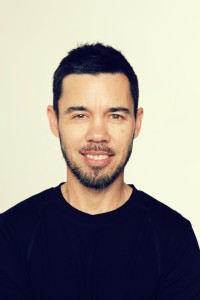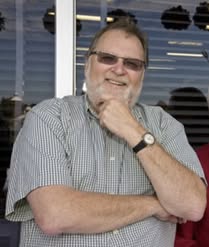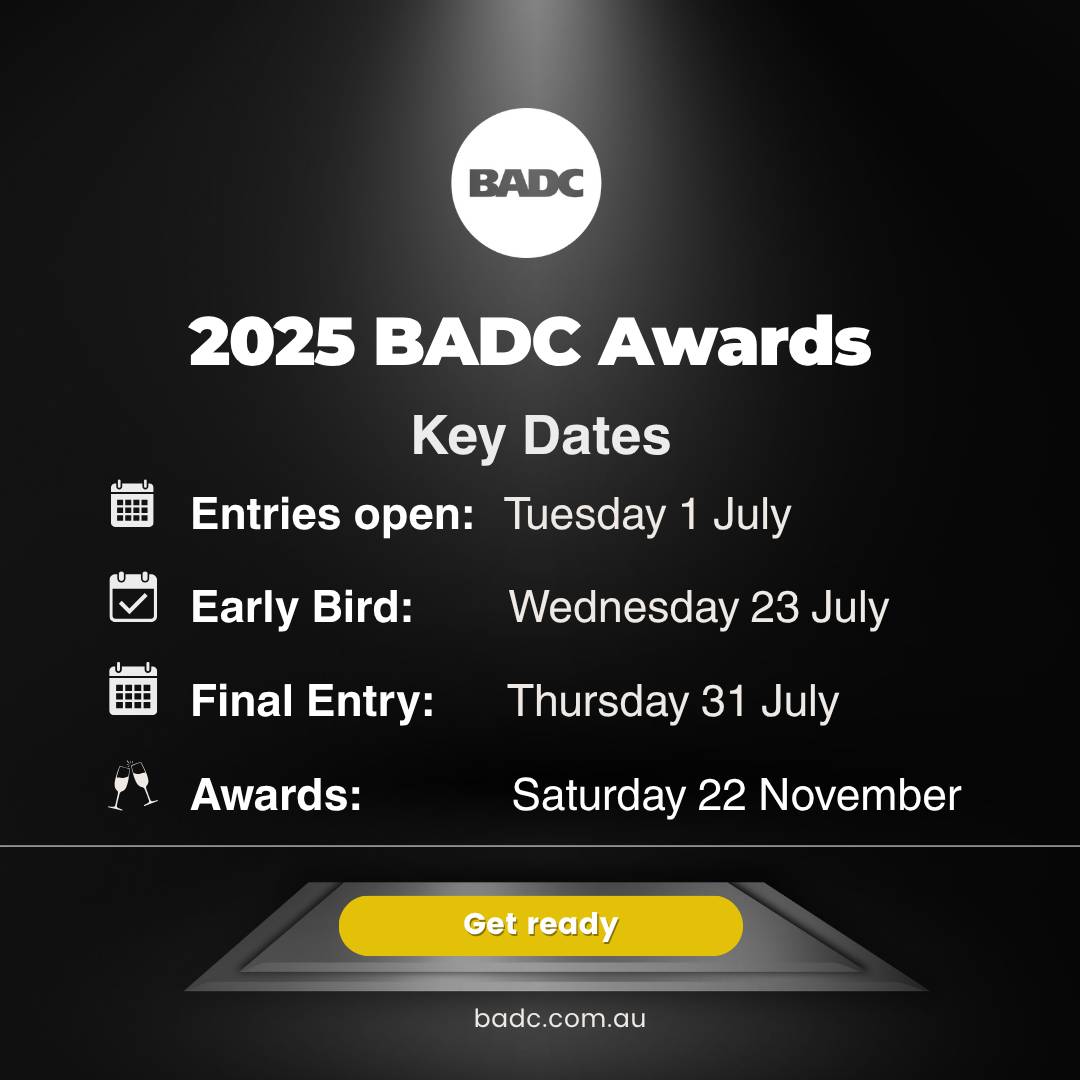
I began my career in 1985, working part-time in the editing suite of pioneering video production house, Jumbuck where my role was to key in the titles of the races during the live edit of the “Track Talk” program. Accuracy was important. It had all to be typed during the video pre-roll prior to each edit and the pre-roll took 10 seconds. So if you couldn’t type “Race 5, Eagle Farm, Brisbane Bitter Handicap” accurately within 10 seconds, you’d be sacked.
During that period I also worked in radio, writing part-time for Brisbane AM station 4BC. It wasn’t just typing that had to be done at speed there. You also had to come up with ideas quickly. The sales reps for the radio station would receive the brief from their clients over lunch, returning with the sketchy details at 3pm (it was the Eighties and lunches were long). The voice over artists were booked to arrived at the studio at 4pm to record as many commercials the writers managed to churn out and everything had to go on air the next day so whatever you wrote had to be approved instantly. You do the math. There was scant time for ideas. You had to be quick to survive. I still tried to write ideas into my scripts and often paid the price by missing deadlines.
Though I enjoyed the pace and the direct to production nature of the radio job, I always wondered what it would be like to play the big ad game in a proper ad agency and to have time to think. I was given that opportunity in 1986 when I was selected for an AFA scholarship by a panel that included John Garnesy from Garnesy Clemenger, Joan Yardley from Monahan Dayman and Adams (which eventually became Mojo MDA) and Bob Walpole from George Patterson Advertising.
I began my six-month scholarship at George Patterson under the watchful eye of co-creative directors Carol Lloyd and Garrett Russell. When the scholarship ended I was kept on, working full time on Pauls and Peters Ice Creams, Fosters Lager and Expo 88. I sat beside actor and voice artist Todd Levi, across from Kevin Goldwater and would greet the big boss who was John Cornwell (Paul Cornwell of BCM’s father) on the stair every morning with a respectful, “Good morning Mr Cornwell.”
On the eve of Expo 88, Carol Lloyd (who had an early career as the lead singer of one of Brisbane’s most famous rock bands, Railroad Gin) left George Patterson to start her own creative consultancy, with a handshake commitment to land part of the Expo 88 business (the creation of the songs and performances that were aired during the event). I was soon invited to join her. I worked at Carol Lloyd’s creative consultancy from 1987 – 1991 through many ups and downs but a lot of laughs.
It was one part retail agency (True Value hardware and Betta Stores through agency Concept) one part event business (Expo 88). It was also responsible for the launch of Shopper Dockets (a new idea then, ubiquitous now) in Australia and the launch of PressPak (the Australian provincial newspaper group that was eventually swallowed up by APN). I left the agency in 1991 and went on to land a job at McCann-Erickson Brisbane six months later at the offices in Gregory Terrace, Fortitude Valley.
At the time, I was teamed up with then art director, now illustrator Ron Monnier and worked beside Kate Moharich (Hunter) with Max Turner, Ian Jensen and Greg Crawford who was CD. The GM at McCann-Erickson was Paul Cornwell. It was a busy agency, conducting fierce rivalry with across-town-agency Mojo. I worked mainly on The Myer Centre business, PUBTAB, as well as the launch of the all-finanz offering of the Suncorp Group and the Jupiters Casino business, which McCann had won from Garnesy Clemenger. When The Commonwealth Bank business was up for grabs and McCann-Erickson’s southern counterparts were toying with the idea of pitching, there was friction created between the agency and Suncorp who themselves were navigating a merger with Metway Bank. That relationship wore thin and eventually Suncorp Metway moved across the river to rival agency Mojo. A pitch to retain the Jupiters Casino business also went badly with that business also going to Mojo. The MD at the time, Mike Hamner left and Paul Cornwell took over.
It was all too much disappointment for me though. Having won a small collection of awards for my work on The Myer Centre and PUBTAB I left McCann-Erickson in 1994 and relocated overseas. Rem Bruijn took my place at McCann-Erickson.
Where would I go? I had a choice between New York and London, having the good fortune of winning two outdoor advertising competitions with air tickets as prizes. The first was The Australian Outdoor Association competition, which I won with Ian Jensen in 1993, for the PUBTAB headline: “If all you do is drink and watch TV, how do you expect to make any money?” The prize was a trip to New York. The second was the General Outdoor Advertising (GOA) competition I won with David Roberts for the women-only golf course (McLeod Country Golf Club) ad: “Play a round with other women. “ That prize was London.
I chose London. Chris Tyquin paid. Thank you, Chris.
I worked in London for several months part-time, doing fill-in jobs for the Omnicom group (which eventually became OMD) before giving up the idea of working in London and instead opting to travel.
One night while I was in Spain, I rang my mother. She she told me she had received a letter from Noel Harris, co-creative director with Greville Patterson of Mojo. It said they needed a new writer and they were wondering if I had grown tired of the London weather yet.
Mojo was the agency I had thought of as public enemy number one during my time at McCann-Erickson. Yet here they were offering me a job as a writer. It was a case of if you can’t beat ‘em, join ‘em and so I did.
Even before my career had started in London, I had called it quits in 1995 and returned to Australia to work at Mojo, teaming up with Adam Whitehead as his writer. Together we worked on Golden Circle, Suncorp Metway, Treasury Casino and The Queensland Tourism business.
Having won almost all of the clients in town and having employed all the available talent to service it, Mojo had become a very large agency by then. Over 100 people were employed there. People like Jo Sellars and Vicki Lee. Greville Patterson spent time there in between his trips to Mojo Sydney. John Summerville was there. Fintan Kerrigan was there (vale), working with Neil Mallett (Sledge) and Greg Crawford too moved there from McCann-Erickson. The agency was run by Austin Kelly and then Andrew Delbridge. There were some fly-ins too. Nick Coombe (also vale) did a short but memorable stint there, leaving in dramatic style.
Ted Horton came through one year too to work on the relaunch of Queensland Tourism. He collaborated with the creative department on the Where Else But Queensland campaign. It was designed to replace the Beautiful One Day, Perfect The Next line, which the strategists had decided was too focused on the Queensland weather, which couldn’t be predicted. Ted was invited in to talk about why the old campaign needed updating in front of the QT board of directors who were fierce defenders of the line. Ted was lined up to give it a bagging. It was thought that Ted’s reputation would add weight to the agency argument against it. It worked. Ted Horton was very convincing.
Having killed off the old line, Ted was however unprepared for what the Chairman of the board would ask him next. What would he be replacing it with? Where Else But Queensland was just a half thought that Ted had bit it hadn’t been discussed with the agency. Still in true Ted style, he offered it up. On reporting back to the agency his announcement went something like this, “OK, so we’ve got this line now. Sorry guys. I had to give the Chairman an answer. So now let’s try to make the fucking thing work.” What followed was an all in creative department cluster fuck and an ad was born.
As they often do in Brisbane several clients of Mojo decided after successful campaigns but too many hard conversations that they needed a new agency and so one after the other they started to leave. Soon after, my art director, Adam Whitehead fulfilled his dream of moving to Sydney and left too. Eventually I decided it was time to move on too.
I was fortunately head hunted to work at Clemenger Brisbane, by the then CD Sandy Peacock. Mainly to work on the Suncorp business that left Mojo for Clemenger. I was delighted by the offer. It was good timing, but having spent the previous 8 years at two different agencies working on the Suncorp business, which both agencies eventually lost, I found it best to be upfront with Sandy about the curse that came with me. Clemenger had just won the account, and was hiring to service it. I warned Sandy I could just as easily lose it for him. So I managed to negotiate a contract that stipulated I should not be asked to work on Suncorp. The curse was broken. Clemenger became the first agency that I would leave before Suncorp did.
But that’s skipping ahead. The first task given to me at Clemenger was to find myself an art director to work with. James Burchill was the eventual choice, having arrived in Brisbane from Sydney with a hip and cool folio. On our first day working together, we discovered that not only did we have similar ambitions to do good work, we also had family in common. James is my long, lost second cousin.
That year, we did what those who’d worked on the account thought was the impossible. We managed good work on Queensland Rail. Beginning with Tilt Train. The commercial wryly depicted a tilt train blowing out a cane fire. It was co conceived by Adam Whitehead (who did it freelance while I was searching for a full time art director) and I. James completed it when he came on board. Another commercial for City Train (an ad about the perfectly timed mascot for the Brisbane Bullets) went on to win BAD’s Best of Show for James and I. We also created what at the time was one of Brisbane’s most memorable commercials for Treasury Casino. The Afro Man commercial. We created an iconic character that spawned costume party ideas for a decade after and had a lot of fun doing it. The Steve and James partnership however was a fertile but short-lived one.
While I had been working at McCann-Erickson, Mojo and Clemenger, I’d been working on the side, on a freelance campaign for a rug maker. Taj Mahal rugs was a client that Judi Bailey and John Stainton managed through their production company Best Picture Show Company. They often needed scripts written. I met Judi while I was working at McCann-Erickson and kept in touch while I was in London. The television ads I wrote for Taj Mahal were directed by John Stainton and produced by Judi Bailey. They were funny and often featured in the award nights at BAD. One year while I was at Mojo, I almost jagged Best of Show with an ad for Taj Mahal, which was a bad look when your award haul for the agency that was paying your salary wasn’t anywhere near as good.
Eventually, Judi handed over the account management responsibilities of Taj Mahal rugs to her son Matthew Bailey who continued to work on the account from his desk at BCM Partnership. I continued to write scripts for Matthew. I also wrote scripts for another client of Matthew and Judi’s: The Rock (Rockhampton’s) Building Society.
The year I left Clemenger was the year the commercial I wrote for The Rock won best of Show at the rival Brisbane Cream Awards. It marked the cementing of a new partnership and the beginning of a new agency.
Myself and Matthew Bailey had decided to launch a startup agency called Junior under the umbrella of an existing ad agency, Peter Huybers Advertising.
This was my ultimate dream. To create an agency culture of my own and to this day, I rate it as my greatest achievement beyond any awards I’ve won. Beginning with foundation clients like Brisbane Marketing and Colorado, Junior went on to secure both the Treasury and Jupiters Casino accounts, as well as NRMA and eventually Bank of Queensland. From day one, Junior was on a fast track to becoming a serious contender, but the culture at Junior was always meant to be different.
I like to think a distinctively quirky agency culture developed at Junior, formed by our hiring policy, which was created out of necessity as much as a view of the sort of people we wanted in our agency. With little to fund high profile hirings from the beginning, we secured talent from the fringes of the advertising industry. Terry Whidborne, the talented illustrator and designer who had never been teamed with a writer before, became my creative partner. We didn’t hire writer/art director teams because Junior could rarely afford them and mostly we didn’t need them. Instead, designer, illustrators, and solo writers were brought into the agency. Sometimes people teamed up, like Matt Emmerson and Sandra Hind who went on to create the Hoopla Family. Sometimes partnerships formed out of friendship like that between Todd Wild and Simon Hipgrave (who now runs his own letterpress printing shop called The Hungry Workshop). Sometimes high profile hirings happened, like Misha McDonald, who was hired from Sydney to work with the amazing photo retoucher and designer/art director Sharon Edmonston. When Terry Whidborne left Junior, Justin Overell took time out from his photo retouching business to team up with me.
This flexible agency creative department structure was also driven by our understanding of the Brisbane market, which seemed to be heading more toward design ideas and experiential concepts than traditional television and press advertising.
It seemed to work for Junior, which separately won both Ad News and B&T’s agency of the year awards as well as international, national and local gongs and maintained a consistent presence in the Top 3 of Campaign Brief’s Brisbane Hot Agency list for the entire decade we were at the helm. The agency grew to be 50 people and be one of the top 3 agencies in Brisbane by billings, and the top two independent agencies.
After ten years, in 2011, Matthew and I sold the agency to the STW Group and left the industry.
The agency is smaller now, taking time to regroup and consolidate after a period of renewal. Junior is now called JuniorCru and it’s under the leadership of Russ Vine and Jonathan Drapes, who were both hired by us as part of our succession planning and also because they’re clever and talented guys. Agency management is like a sprint relay. It’s not an endurance event. You need to hand the baton over to someone fresh when you’re tired of sprinting, before you just can’t go on. It was time for Matthew and I. We were exhausted and Russ and Jonno where next fresh thing.
But the creative days aren’t over for me. These days, I spend my time creating food ideas with Matthew. Our restaurant chain Harajuku Gyoza has grown to three outlets (Fortitude Valley, Potts Point Sydney and Indooroopilly) and we’re about to open our fourth. We’re excited to say Harajuku Gyoza was this year rated one of Australia’s top eight food concepts by theurbandeveloper.com
Meanwhile, our other food idea, Nitrogenie, a liquid nitrogen ice cream business is being prepared for franchising. There are Nitrogenies in Noosa Heads, South Bank Brisbane, Indooroopilly and our first overseas franchise opened recently in Bangkok Thailand. We have fielded hundreds of enquiries from franchisees in 15 countries and will soon begin rolling out more Nitrogenies internationally in the coming months.
Though the ideas I have are no longer advertising ideas, they’re still ideas. I’m still in the ideas business and much of what I do is marketing at the least and sometimes advertising. It’s just that after 25 years of writing and creating ideas for other businesses, I’m now enjoying creating ideas for my own businesses. I still miss advertising though. Mainly the people.





